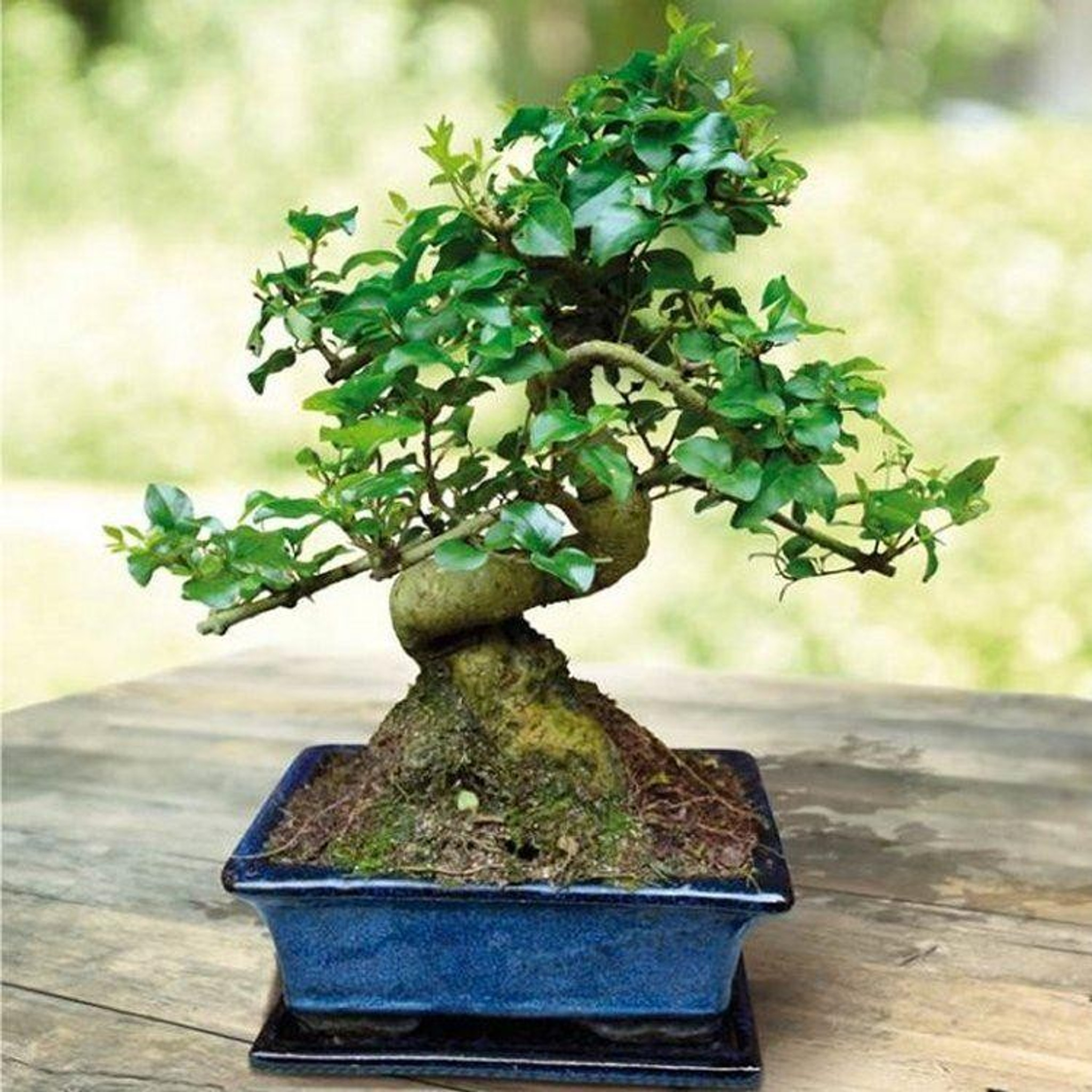
Bonsai Ligustrum S Shape
The Ligustrum sinense is a fabulous indoor bonsai variety and a relative of the Olive tree (Oleaceae Family).
This is without doubt an all-time favourite beginners indoor bonsai and has so much to offer.
It is very fast growing, making it fun to prune and style.
It is very easy to care for and not fussy about where it should be positioned.
It has a strong and vigorous trunk and shoots, resulting in bonsai with a powerful and artistic structure.
The leaves of this beautiful indoor bonsai have great proportions with smooth edges and a wonderful fresh spring green in colour. This results in a very pretty and full canopy of leaves.
As the bonsai matures it also displays pretty white/creamy coloured flowers.
Grown as an indoor bonsai variety the Ligustrum is evergreen and keeps its leaves all year round. In our experience leaf drop is absolutely minimal.
As a fast growing bonsai species this bonsai is a hungry tree which likes to be frequently fed with bonsai food, but is very rewarding.
A great variety to practice bonsai skills such as pruning and wiring. It is easy to style and will produce a well structured and highly artistic bonsai. It will form beautiful informal upright or broom style bonsai trees.
We believe this to be an exceptional bonsai that does not receive the credit that it deserves.
An under-rated indoor bonsai variety in our opinion but one we highly recommend.
Tree meanings
Bonsai in general symbolise peace, harmony, order of thoughts and balance.
The ligustrum sinense symbolises peace and friendship.
Ligustrum Indoor Bonsai Care Summary
Positioning & Temperature
The Ligustrum is an easy indoor bonsai species to care for. It likes a bright position, with good natural daylight, but as with all bonsai, should not be placed in a very hot position in mid-summer. It is not fussy about temperature, but it is not frost hardy so would not be suitable to grow as an outdoor bonsai during the winter months.
Watering
Watering is a lovely and essential part of bonsai tree care. It is a simple, yet vital part of growing bonsai and only takes a few seconds. We recommend whilst you are learning to check the soil daily. If the soil is wet or very damp, please do not water your bonsai. When the soil starts to firm and feels barely damp to the touch, water well by either standing the bonsai in water for a few minutes or by pouring water over the soil surface to re-wet the root ball evenly.
Misting
Misting the leaves of your Ligustrum bonsai is not essential, but does enhance the growth during winter months in particular. In the winter, when the central heating is on, the air can get very dry and misting will simply replace some of the lost humidity and encourage new foliage growth.
Feeding
Feeding bonsai trees is good practice. The bonsai rely on us to provide the nutrients and trace elements they need. A well balanced bonsai feed, such as Bonsai Focus, will maintain healthy and beautiful trees and promote growth, fruiting and flowering.
Pruning/Styling
The Ligustrum Bonsai is a relatively fast growing bonsai variety and is fun to prune and style. The new shoots are often flecked with russet tones which really does make it look very pretty. To maintain the lovely highly defined foliage pads and pretty canopy it is important not to let the shoots grow too long and straggly. By keeping the shoots trimmed, you will be encouraging back budding and new leaves to grow. Most new growth will appear during spring or summer. Allow a shoot to grow approx. 4cm and then prune back to the first two new leaves. Use a sharp pair of pruning scissors to do this. Within 4-6 weeks you can usually see signs of new shoots emerging further back down the branches, it is very rewarding.
If you would like to try some re-styling you could try some wiring techniques. Generally, wiring is used to give a branch or slender trunk more character and shape.
Growing/Propagating your own Ligustrum bonsai trees
We are frequently asked for bonsai seed kits but the reality is that thee kits are rather a disappointed. They frequently don’t germinate and it is not the best way to propagate indoor bonsai trees. You are far better to purchase a bonsai, so you can enjoy growing it, and propagate new bonsai by taking cuttings.
These are best taken in spring. Allow new shoots to grow 8-10cm and then prune with clean pruning scissors. Pop these cuttings into some fresh multipurpose compost in a small pot. Water them and then keep misting to maintain humidity.
Re-potting your bonsai
If a bonsai becomes pot bound the roots cannot grow. Consequently, the tree cannot grow. The younger the tree the quicker it is growing and the more frequently it will require root pruning or re-potting. As a general rule you are looking at approximately every 2-3 years, and older specimens every 4-5 years. If the pot that your bonsai is in is aesthetically large enough, you may simply be able to root prune your bonsai and it may not require a larger pot at all. Re-potting is best done when the bonsai is actively growing during the warmer summer months. If the bonsai requires a larger pot, simply lift the root ball out of the current pot, tease out approximately one quarter of the root ball with a chop stick to loosen the roots around the edge and position into its new, slightly larger, pot. Use good quality, free draining soil, such as Akadama, and work around the edge of the pot. Stand your re-potted bonsai in water, so that the water covers the whole pot, for approximately 5 mins and then allow to drain.
Akadama is a high quality Japanese bonsai soil made from dried loam. It is granular, so is free flowing and easy and clean to work with. The small balls also encourage the growth of lovely fibrous feeder roots, which is what we want when growing bonsai trees.
Bonsai tips
Please avoid using air freshener near your bonsai, they are not overly keen!
Ligustrum bonsai trees respond well to the use of a Plant Invigorator to help keep the free from pests and help promote new growth. We use this weekly as a preventive measure.







